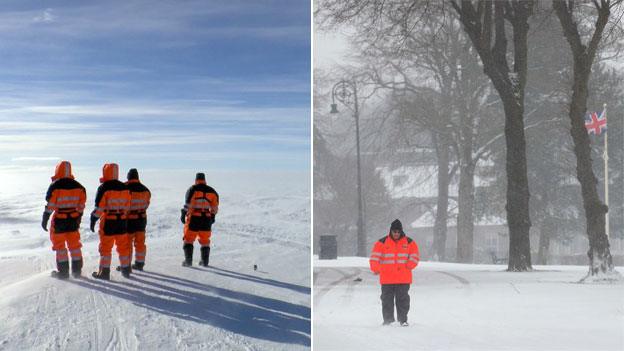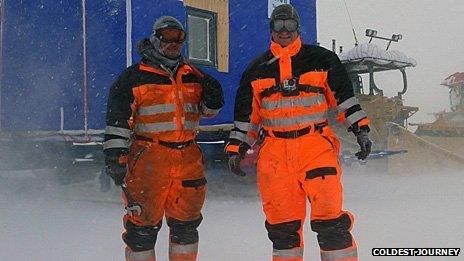Sir Ranulph Fiennes: Coping with extreme weather
- Published

The Coldest Journey team (left) and a postman in Buxton, Derbyshire
Sir Ranulph Fiennes, who recently returned to the UK after his latest Antarctic expedition, explains the impact of extremely cold weather - and how to cope with it.
Surviving in the coldest places on earth isn't easy.
I recently returned to the UK after developing a case of frostbite on my latest expedition in Antarctica, which we nicknamed "The Coldest Journey". The epic journey, which aimed to complete the first ever trans-Antarctic crossing during the polar winter, has continued without me, with a highly experienced team of four Britons and one Canadian.
Back at home, people have been dealing with their own coldest journey commuting to work in recent weeks.
The long cold period, matched by northerly winds, isn't quite as cold as what the team will be experiencing in Antarctica - which could drop to as low as -90°C - but is cold enough to have an effect on daily activities, or at least put some people off going outside unless they have to.
People often ask me how explorers cope with such demanding conditions in some of the most isolated places on the planet.
Each foray I've made into the Arctic and Antarctic has confirmed that low temperatures without the wind are relatively bearable, providing that your clothing is sufficient.
In Antarctica in particular you have high altitude to deal with which lends itself to being very windy. In the polar regions, even the smallest of holes in your warm clothing can have major implications on your core temperature and survival. If you are sweating and cold air manages to get inside your layers then you are in trouble.
The team in Antarctica now will have a particular mindset in order to cope with the low temperatures, and also the cabin fever, which may be an issue if a really bad patch of weather sets in and they are forced to stay inside the caboose for a long amount of time.
They will need to be constantly alert to the cold temperatures and mustn't get complacent, even if they've been out in those conditions many times before.
In extreme cold, you can't think that your natural attributes will work as well as they usually do. In my case, I'd proved in various situations that my circulation was fine, even better than colleagues on previous expeditions, yet suddenly two weeks ago, during a whiteout at -33°C, and after only 15 minutes of exposure, one hand had a problem but the other one was fine.
The cold can affect you in strange ways, mentally and physically. To be mentally prepared for such extreme and demanding environments is incredibly difficult.

Suitable clothing is a must
Carrying out detailed planning so that you are confident in the expedition and its success is key, as is developing a mental toughness when faced with difficult situations. It is imperative to stay focused and not to panic if something bad or unexpected happens.
As an expedition member, you must believe in yourself and your abilities, and know your role within the expedition inside out. Preparation is key.
In a group situation, when one person is having a down day, it is important for the others to pull him back up and motivate him and keep him focused. Everyone will have a down day, but in a team environment they will help each other and work together to reach the end goal.
You never know what, or when, is going to be the hardest point of an expedition. It varies from one person to another. Of course, if there is a problem with a big crevasse, or with the equipment, or with an extended period of really extreme cold, then tensions can set in. Even with planning, there will be unknowns, but the unpredictable element is what makes it such a challenge.
To be physically prepared for extreme temperatures, training to get fit is critical, and you can try to put on weight to give you a bit of a cushion. Obviously, it also helps to research the best cold weather gear for whatever particular activity you are undertaking as well, so you are as well-equipped and warm as possible on the expedition.
What makes the Coldest Journey so unique is that it is the first attempt to traverse Antarctica during polar winter, so not only will it be cold, it will be completely dark for much of the expedition, which is also likely to affect the team's mindset.
When the weather sets in you cope with it like any other person. We play cards, draughts, backgammon, write blogs, write to the nearest and dearest, watch DVDs, listen to wild west music if you're Spencer Smirl…
And the team has seven or eight furry little mascots. I had a pink elephant from my daughter, Rob Lambert the doctor has two penguins, someone else has a power gorilla. There is also a busy little mouse called Mary, who seems to be the most notable. These mascots keep the team going.
You also have to do a huge amount of careful preparation and selecting when recruiting the team for an expedition. People need to be physically strong, but you also have to test them mentally and test their character very carefully.
I've used a team of selectors to help in the past, as you need to be very sharp in watching people very closely under strained circumstances. You need to know if anyone is going to fall to pieces at -40C before you start an expedition.
I've been lucky with coming back into "normal" society after expeditions. For my three previous expeditions across both poles, my late wife was the radio operator so we were together for the adventures.
Since then I've remarried, and when I came back last week to my wife, I hadn't been away for too long, so it was relatively easy to get back into family life.
Then there's the world around you. I remember returning from one expedition when the price of margarine spread had gone up from 1 and 6d before I left to 70p when I got back. Not only had the price changed, but the currency had as well.
You can follow the Magazine on Twitter, external and on Facebook, external
- Published25 February 2013